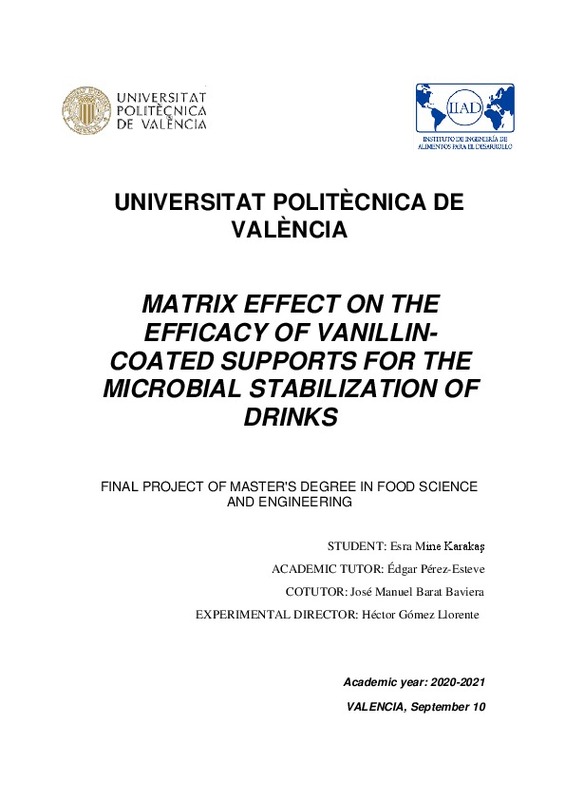|
Resumen:
|
[ES] La industria alimentaria urge desarrollar nuevas tecnologías para mitigar o incluso reducir los efectos negativos de los métodos de conservación convencionales (como los procesos térmicos o el uso de conservantes ...[+]
[ES] La industria alimentaria urge desarrollar nuevas tecnologías para mitigar o incluso reducir los efectos negativos de los métodos de conservación convencionales (como los procesos térmicos o el uso de conservantes químicos). Una de las estrategias propuestas recientemente para reducir la carga microbiana de diferentes productos alimenticios líquidos consiste en usar de partículas de sílice funcionalizadas con vainillina a modo de lecho de filtración. Sin embargo, se ha observado que el poder antimicrobiano de estas partículas cambia en función de la matriz alimentaria (zumo, leche, vino¿). Este estudio se centra en aclarar el efecto de los componentes individuales de las matrices alimentarias típicas (sales, proteínas, carbohidratos, lípidos, etanol, ácidos) sobre la capacidad del sistema de filtración para reducir o eliminar la carga microbiana inicial. Para ello, se funcionalizaron micropartículas de sílice (50-110 µm) con vainillina. Se prepararon diferentes modelos de alimentos con diferentes concentraciones de albúmina sérica bovina, sacarosa y lactosa, aceite de girasol, ácido cítrico etanol, MgCl2, CaCl2 y NaHCO3. Para cada concentración, se filtraron 100 mL de modelos de alimentos inoculados con Escherichia coli a través de una capa de soportes funcionalizados con vainillina. Primero, se determinó la concentración máxima de los diferentes compuestos orgánicos e inorgánicos que se pueden utilizar hasta que el filtro pierde su actividad. Luego, se realizó un estudio de vida útil, definido como la cantidad de litros que se pueden filtrar hasta perder la capacidad de reducción de tres ciclos logarítmicos. Los resultados mostraron que, si bien los componentes inorgánicos no afectan la capacidad antimicrobiana, la presencia de compuestos orgánicos en el medio filtrado puede tener diferentes impactos en la efectividad antimicrobiana del filtro. Mientras que las proteínas, lípidos o lactosa reducen la vida útil hasta un 11%, la presencia de ácidos orgánicos o alcohol la aumenta cerca de un 200%.
[-]
[EN] Food industry is in urge to develop new technologies to mitigate or even reduce the negative effects of conventional conservation methods (such as thermal processes or the use of chemical preservatives). One of the ...[+]
[EN] Food industry is in urge to develop new technologies to mitigate or even reduce the negative effects of conventional conservation methods (such as thermal processes or the use of chemical preservatives). One of the recently proposed strategy to reduce the microbial load of different liquid food products involves the use of silica particles functionalized with vanillin as a filtering bed. However, it has been noticed that the antimicrobial power of these particles changes depending on the food matrix (juice, milk, wine¿). This study is focused on clarifying the effect of single constituents of typical food matrices (salts, proteins, carbohydrates, lipids, ethanol, acids) on the capability of the filtration system to reduce or eliminate the initial microbial charge. To this end, silica micro particles (50-110 µm) were functionalized with vanillin. Different food models with different concentrations of bovine serum albumin, sucrose and lactose, sunflower oil, citric acid, ethanol, MgCl2, CaCl2 and NaHCO3 were prepared. For each concentration, 100 mL of inoculated food models with Escherichia coli were filtered through a layer of vanillin-functionalized supports to assess the initial removal capability. First, the maximum concentration of the different organic and inorganic compounds that can be used until the filter lose its activity was determined. Then, a shelf-life study defined as the number of liters that can be filtered until losing the reduction capacity of three logarithmic cycles was carried out. Results showed that while the inorganic constituents do not affect the antimicrobial capacity, the presence of organic compounds on the filtered media can have different impacts on the filter¿s antimicrobial effectivity. While proteins, lipids or lactose reduce the shelf-life up to a 11%, the presence of organic acids or alcohol increases it close to a 200%.
[-]
|







